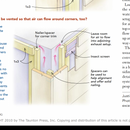Rainscreen corners: flow or no flow?
I am looking for input on whether or not to block off airflow around corners in my rainscreen assembly. It is recommended to block flow with 1×3’s in the FHB article “keeping siding dry with a vented rainscreen”. I have attached a screenshot of that section. I could find no other article that touched on this.
Would someone explain to me in what situation rain might be “dragged around the more vulnerable corners” as the article states? It seems to me that if I use my corrugated rainvent battens (3/8″) to make “open corners”, ventilation air movement spurred by stack effect on sunny walls may be able to encourage air movement on dark walls. This seems a positive as my house’s long axis is E-W and the long north wall will seldom get sun.
Thanks!
GBA Detail Library
A collection of one thousand construction details organized by climate and house part










Replies
Tanner,
- Our code allows trim to be fastened to the battens, or directly to the WRB. I've never heard of any appreciable difference in longevity between the two approaches.
- With vertical rain-screen battens, I don't see how you end up with any horizontal air movement, unless you deliberately introduce it.
- It's a pretty old article.
I’m not sure how horizontal airflow is a benefit, except around windows and doors where you’d otherwise have rainscreen sections that weren’t open at one end or the other. Rainscreens are a benefit due to their better drying ability, and they rely on convection currents to do that. Convection air currents only move vertically.
Bill
Air currents move in any direction where there is a pressure difference. In rainscreen walls, that pressure difference can be the buoyancy of warmer air in the cavity. But there are other sources of driving pressures.
The worry about open corners is wind. When wind blows around the corner of a building, it often causes high pressure zones on one side and low(er) pressure zones on other sides. If this pressure tries to equalize around the corners within the rainscreen cavities, it could conceivably cause some of that moisture to be driven into the walls where the net cavity pressure is greater than the interior house pressure.
Malcolm, as the battens are corrugated plastic ( Dupont Rainvent) they could allow horizontal airflow when installed vertically (as they are). Peter, ok I could see wind moving some drops around a building corner, though I don't follow how that would increase the pressure differential between the rainscreen cavity and the building interior.
Tanner,
Apart form this article I've never heard of this as a concern one way or another. In the absence of something more I wouldn't lose any sleep over it.
Haha sounds good, thanks Malcolm!
As far as I know, it's far more of a concern in tall buildings where wind pressure differences are seriously higher. I can't think of any situation where it would be an issue for a residential structure.
I've had painted exterior wood trim rot quickly due, I believe, to solar vapor drive, so I now try to provide at least a capillary break behind corner boards and casings.
Ventilated rain screen for cornerboards is just as important if not more so than in the field of a wall. Windwashing can make corners wetter and because cornerboards are not lapped but continuous, if water gets behind them, it gets trapped. Free-drainage and air movement are needed.
Peter